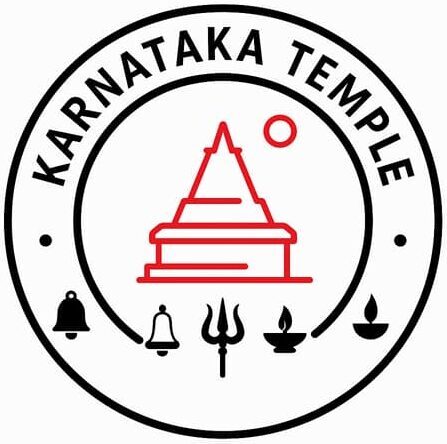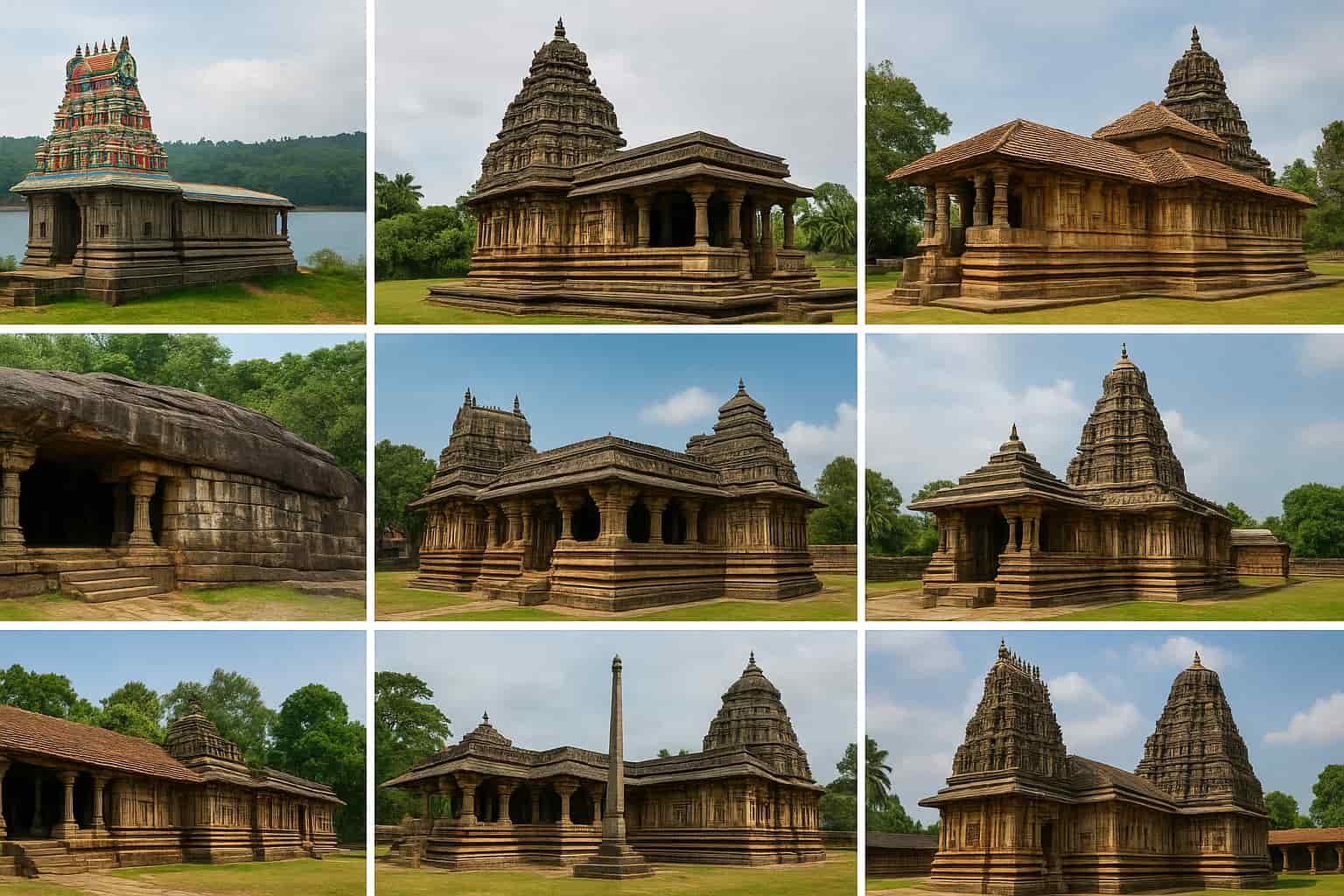Shivamogga (Shimoga) sits where the Western Ghats meet great rivers—Sharavathi, Tunga and Bhadra—so temple stories here feel soaked in mist and water. On the Sigandur backwaters, Chowdeshwari is famed for vow-slips and an island setting; the old capitals of Keladi and Ikkeri preserve Nayaka-era halls and shadowy Shaiva sanctums. Farther east, Balligavi and Talagunda keep inscriptions and mixed-style shrines that blur myth with early Karnataka history, while Koodli marks the meeting of two mighty rivers. You’ll also meet Hoysala craft at Bhadravathi and a raw rock-cleft Shakti shrine at Chandragutti—places where echo, light and local vows turn worship into living mystery.
In this guide, we uncover Shivamogga’s most mysterious temples with quick legends, what to look for, best times to visit, and practical tips—so you can explore Malenadu’s most atmospheric sanctums with confidence.
📜 A Quick Glimpse at Shivamogga’s Most Mysterious Temples
A compact map of legends—from island shrines and confluence rituals to cave sanctums and Hoysala stone “puzzles.”
🛕 1. Sigandur Chowdeshwari — The Ferry-to-the-Goddess Vow Shrine
In the Sharavathi backwaters near Sagara, devotees cross by ferry to reach this island-like shrine of Chowdeshwari. Visitors pin written vows and keep “receipt” slips as tokens of protection. With wind off the reservoir and temple bells across water, Sigandur feels half-pilgrimage, half-journey into myth.
| Temple Name | Sigandur Chowdeshwari Temple, Sagara taluk |
| District | Shivamogga (Shimoga) |
| Nearby Place | Sharavathi backwaters; Jog Falls (farther north) |
| How to Reach | Drive from Sagara; final approach includes a short ferry. Peak weekends can be crowded—start early. |
| Google Maps | Directions to Sigandur Chowdeshwari |
🔍 Why Sigandur Feels Mysterious
- ⛴️ Island approach: Reaching by ferry heightens the sense of a boundary between everyday life and the sacred.
- 📝 Vow slips: Written pledges and “receipts” are cherished as spiritual protection.
- 🌬️ Backwater acoustics: Wind and water carry bells and chants across the reservoir.
🛕 2. Keladi Rameshwara — Nayaka Halls & Whispering Corridors
Once a Nayaka capital, Keladi preserves stone-and-wood pillared halls leading to a Shaiva sanctum. Palm-leaf lore, royal legends and the cool, shaded corridors create an atmosphere where footsteps echo and stories seem to travel with the breeze.
| Temple Name | Keladi Rameshwara Temple, Sagara taluk |
| District | Shivamogga (Shimoga) |
| Nearby Place | Keladi Museum; Ikkeri (Aghoreshwara) |
| How to Reach | Short drive from Sagara town; roads are good year-round. Combine with Ikkeri in one loop. |
| Google Maps | Directions to Keladi Rameshwara |
🔍 Why Keladi Feels Mysterious
- 🏛️ Wood–stone fusion: Nayaka-era halls create shifting patterns of light and shadow.
- 📜 Royal memory: Stories of Keladi’s queens and palm-leaf records give the site a time-capsule feel.
- 👂 Acoustic corridors: Low voices travel far, adding to the “whispering” aura.
🛕 3. Aghoreshwara, Ikkeri — Granite Dravida & Fierce Shaiva Icon
A massive granite temple set on a raised plinth, Ikkeri’s Aghoreshwara blends stern Dravida lines with deep porches. The fierce aspect of Shiva, heavy doors and echoing mandapas kindle a sense of primordial power—especially at dusk when lamps flare up inside.
| Temple Name | Aghoreshwara Temple, Ikkeri (near Sagara) |
| District | Shivamogga (Shimoga) |
| Nearby Place | Keladi; Sagara town |
| How to Reach | Good road from Sagara; parking near the base. Evenings offer dramatic light. |
| Google Maps | Directions to Aghoreshwara (Ikkeri) |
🔍 Why Ikkeri Feels Mysterious
- 🪨 Granite massing: Heavy stone and deep porches create dramatic shadow pockets.
- 🔥 Aghora aspect: The fierce Shaiva presence intensifies during lamp-lit rituals.
- 🔊 Echoing mandapa: Bells and chants roll through the halls with reverb.
🛕 4. Kedareshvara, Balligavi — Where Inscriptions Speak History
Balligavi was a medieval learning and temple center; Kedareshvara fuses Nagara and Dravida elements with inscription stones around. Local lore mentions old subterranean links and sanctum secrets—paired with very real epigraphs that map early Karnataka history.
| Temple Name | Kedareshvara Temple, Balligavi (Shikaripura taluk) |
| District | Shivamogga (Shimoga) |
| Nearby Place | Shikaripura; Talagunda |
| How to Reach | Rural roads from Shikaripura; plan daylight visits to read inscriptions clearly. |
| Google Maps | Directions to Kedareshvara (Balligavi) |
🔍 Why Balligavi Feels Mysterious
- 🔠 Epigraphic aura: Inscriptions outline dynasties and donors—history “written on walls.”
- 🧭 Hybrid style: A blend of Nagara–Dravida forms leaves scholars debating influences.
- 🕳️ Subterranean lore: Tales of old passageways add to the hush around the sanctum.
🛕 5. Pranaveshwara, Talagunda — The Inscription that “Tells” of Beginnings
Talagunda’s famed inscription narrates early Karnataka history and the rise of the Kadambas. The small, serene Pranaveshwara shrine stands amidst fields and old stones—quiet enough that a breeze can sound like a page turning in time.
| Temple Name | Pranaveshwara Temple, Talagunda (Shikaripura taluk) |
| District | Shivamogga (Shimoga) |
| Nearby Place | Balligavi; Shikaripura |
| How to Reach | Rural approach roads; plan early morning or late afternoon for soft light on inscriptions. |
| Google Maps | Directions to Pranaveshwara (Talagunda) |
🔍 Why Talagunda Feels Mysterious
- 📜 Origin story: The inscription “speaks” of kings and sages, anchoring myth to history.
- 🌾 Rural hush: Fields and distant birds create a contemplative soundscape.
- 🪔 Small sanctum: A simple, old-world garbhagriha heightens the feeling of age.
🛕 6. Rameshwara & Sangameshwara, Koodli — At the Meeting of Two Rivers
At Koodli, the Tunga and Bhadra merge to become the Tungabhadra. Two old temples and matha traditions mark the confluence, where the sound of swirling waters mixes with conch and bell—especially powerful at sunrise pujas and on festival days.
| Temple Name | Rameshwara & Sangameshwara Temples, Koodli (confluence) |
| District | Shivamogga (Shimoga) |
| Nearby Place | Shivamogga city; Bhadravathi |
| How to Reach | Easy drive from Shivamogga/Bhadravathi. Best light at sunrise/sunset over the sangam. |
| Google Maps | Directions to Koodli (Sangama) |
🔍 Why Koodli Feels Mysterious
- 🌊 Confluence power: Meeting of rivers is held to amplify prayer and penance.
- 📿 Matha traditions: Monastic lineages keep ritual cycles and sacred learning.
- 🎺 Water & sound: Conch and bell mix with the rush of currents for a unique soundscape.
🛕 7. Lakshmi Narasimha, Bhadravathi — Hoysala Stone “Puzzle” in a River Town
A star-plan Hoysala shrine with crisp narrative bands and a lively Narasimha focus. During evening aarti, faces on the friezes seem to glow from within, while the zig-zag walls cast deep chevrons of shadow across the platform.
| Temple Name | Lakshmi Narasimha Temple, Bhadravathi |
| District | Shivamogga (Shimoga) |
| Nearby Place | Koodli; Bhadra River bridges |
| How to Reach | In Bhadravathi town; connect from Shivamogga by bus/train. Evenings are best for photos. |
| Google Maps | Directions to Lakshmi Narasimha (Bhadravathi) |
🔍 Why Bhadravathi Feels Mysterious
- ⭐ Star plan: Stellate walls create optical depth and shifting shadow bands.
- 🦁 Narasimha icon: Dramatic panels feel animated under lamp light.
- 🕯️ Evening glow: Aarti reflections make the figures “come alive.”
🛕 8. Renukamba (Chandragutti) Cave Temple — Goddess in a Rock Cleft
Cut into a natural cleft on a hill near Soraba, this Shakti shrine is reached by steep steps and rock passages. Devotees bring vows and offerings, and point to marks on the stone tied to Renuka legends—an experience that feels raw, elemental and intimate.
| Temple Name | Renukamba (Chandragutti) Cave Temple, Soraba taluk |
| District | Shivamogga (Shimoga) |
| Nearby Place | Soraba; Siddapura (via Malenadu routes) |
| How to Reach | Hill climb with steps/rock paths; avoid slippery times after heavy rain. Carry water and a shawl. |
| Google Maps | Directions to Renukamba (Chandragutti) |
🔍 Why Chandragutti Feels Mysterious
- 🕳️ Natural cave: The sanctum is a rock cleft—earth, wind and lamp-smoke set the mood.
- 🙏 Vow culture: Devotees attribute fulfilled wishes to the Goddess’s grace.
- 🌿 Hill aura: Forested slopes and mist make the climb meditative.
Other Mysterious Temples in Shivamogga
Humcha (Hombuja) Padmavati Jain Basadi — ancient Jain center where the serpent-hooded Goddess and hushed stone corridors create a meditative stillness.
Tripurantakeshava Temple, Balligavi — a lesser-known twin to Kedareshvara; Hoysala–Vijayanagara layers and a rare syncretic name linking Shiva’s Tripurantaka and Vishnu’s Keshava.
Gudavi Siddeshwara Temple, Gudavi (Sorab) — lakeside shrine beside the bird sanctuary; monsoon waters mirror the sanctum as peepal leaves whisper over chants.
Varadahalli (Varadapura) Sri Sridhara Swami Ashram — wooded climb, dharma-dhwaja and cave-like meditation spots around the guru’s samadhi; rain streams add to the hush.
Rameshwara Temple, Thirthahalli — riverside Shiva on the Tunga’s bend; evening lamps reflect on slow current, turning aarti into moving gold.
Ambuteertha Rameshwara (Thirthahalli taluk) — site where legend says Rama’s arrow sprung a perennial pond; a compact shrine by a clear spring.
Neelakanteshwara Temple, Nagara — mossy fort-town backdrop with a granite sanctum and misty tank; echoes of Keladi-Nayaka days linger in the stone.
Kavaledurga hill-shrine ruins — tiny Shiva/Vishnu shrines tucked inside a ruined hill fort; sunrise fog and silent walls amplify the mystery.
Planning Your Temple Trail in Shivamogga
From the ferry-to-the-Goddess vows at Sigandur and the whispering corridors of Keladi to the granite might of Ikkeri, Shivamogga’s shrines feel shaped by river, mist and forest. Eastward, inscriptions at Balligavi and Talagunda anchor legend to early Karnataka history, while Koodli’s confluence rituals blend water and bell-sound. For raw, elemental devotion, Chandragutti’s cave sanctum stands apart; in town, Bhadravathi offers a Hoysala stone puzzle under evening lamps.
A relaxed loop works best: start around Sagara for Sigandur–Keladi–Ikkeri, then circle through Balligavi and Talagunda, wind down at Koodli by sunset, and add Bhadravathi or Chandragutti if time and weather allow. Keep space in your schedule to sit, listen, and let each sanctum’s light and acoustics reveal their own quiet mysteries.
- Best light: 8–10am and 4–6pm for shadows on carvings; mist adds drama in the monsoon but paths can be slick.
- Sigandur tips: Check ferry timings locally; weekends see heavy vow crowds—arrive early.
- Dress & etiquette: Modest clothing; follow photography rules; avoid touching carvings and queuing areas.
- Monsoon safety: Steps and rock paths (especially Chandragutti) can be slippery—wear shoes with grip.
- Carry small change: For shoe-stands, prasada, and village parking; ATMs may be sparse on rural stretches.

